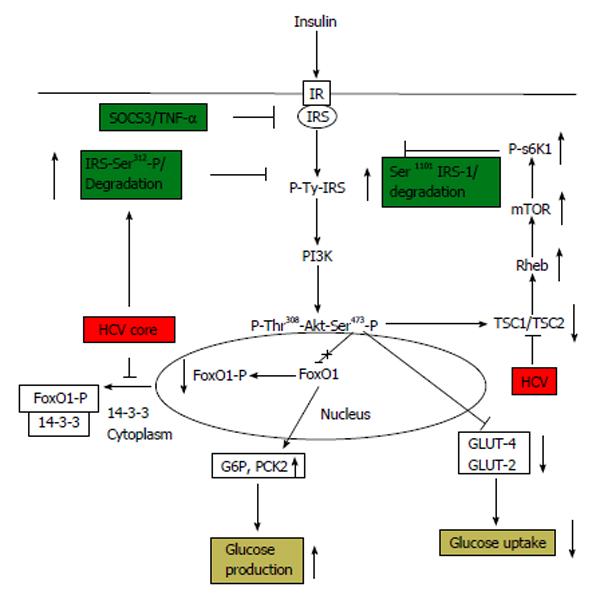Copyright
©2014 Baishideng Publishing Group Co.
World J Diabetes. Feb 15, 2014; 5(1): 52-58
Published online Feb 15, 2014. doi: 10.4239/wjd.v5.i1.52
Published online Feb 15, 2014. doi: 10.4239/wjd.v5.i1.52
Figure 1 Schematic showing the interference of Hepatitis C virus in the insulin signaling pathway.
Hepatitis C virus (HCV) core protein is known to up regulate Ser312 phosphorylation of insulin receptor substrate (IRS)-1 leading to degradation of IRS-1, the key molecule involved in propagation of insulin signal downstream from the insulin receptor (IR). HCV infection is also known to down regulate TSC1/TSC2 complex, resulting in subsequent upregulation of mTOR/S6K1 which leads to Ser1101 phosphorylation of IRS-1 and its subsequent degradation. A role of HCV mediated upregulation of SOCS3 and tumor necrosis factor-α (TNF-α) has also been proposed which leads to degradation and blocking of IRS-1 function. HCV also upregulates glucose 6 phosphatase (G6P), phosphoenolpyruvate carboxykinase 2 (PCK2) leading to increased glucose production, and down regulates glucose transporter (GLUT)-4, GLUT-2, leading to decreased glucose uptake by hepatocytes. Overall, these alterations lead to insulin resistance. mTOR: Mammalian target of rapamycin.
- Citation: Bose SK, Ray R. Hepatitis C virus infection and insulin resistance. World J Diabetes 2014; 5(1): 52-58
- URL: https://www.wjgnet.com/1948-9358/full/v5/i1/52.htm
- DOI: https://dx.doi.org/10.4239/wjd.v5.i1.52









